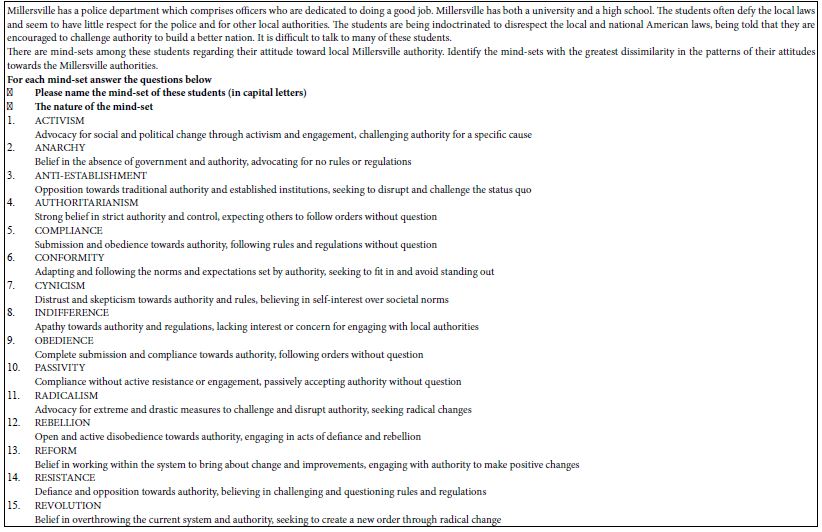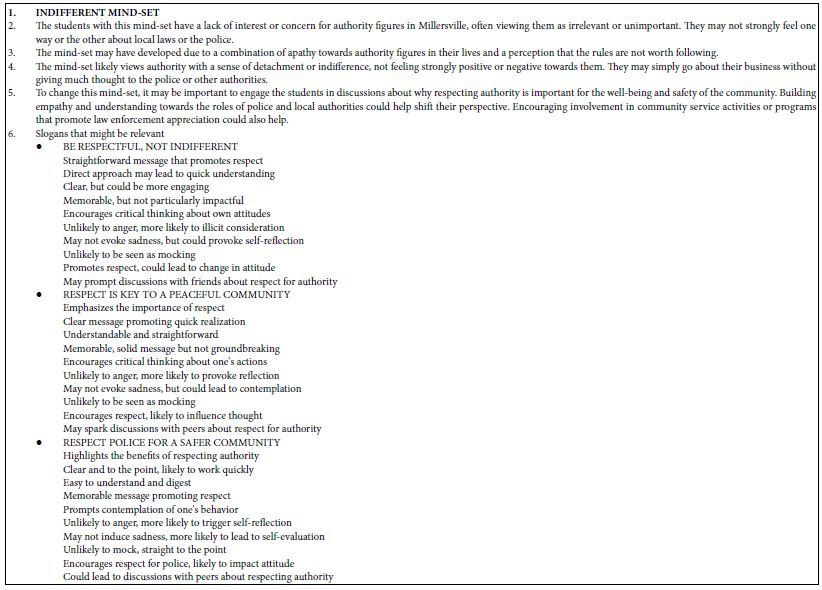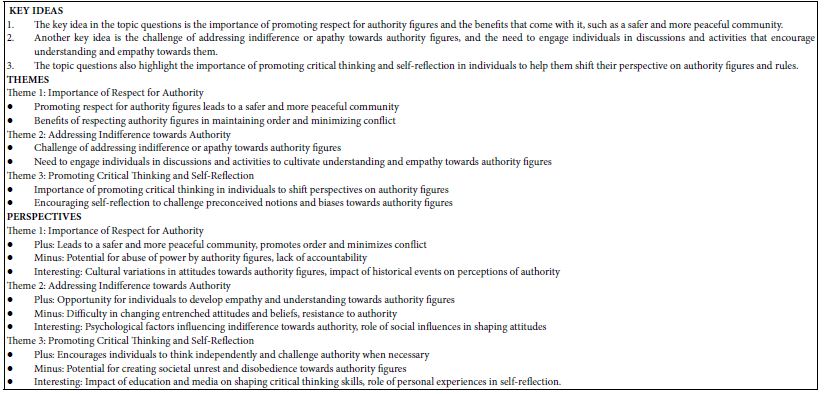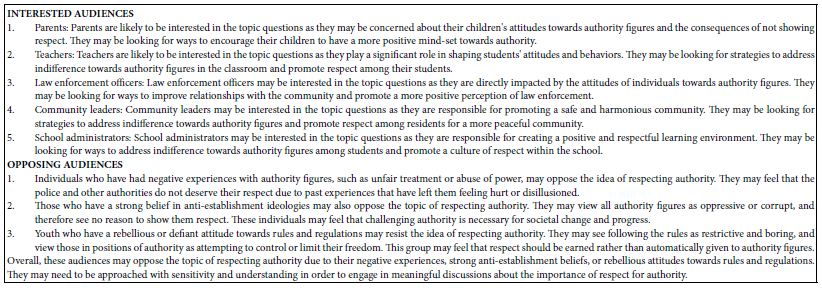Abstract
Using a combination of Mind Genomics thinking and artificial intelligence through LLMs (Large Language Models), the paper shows how police officers can understand the different mind-sets of students and others in college towns. The paper shows how to deal with a specific mind-set, INDIFFERENT, in order to encourage law-abiding behavior. The approach is generalizable, easy to use anywhere and anytime, with the ability for the user to incorporate situation-specific information as deemed relevant.
Keywords
Artificial intelligence, Authority, College towns, Mind genomics, Mind-set, Students
Introduction
Police officers in college towns often face unique challenges due to a diminished respect for the local police force. With the presence of a large student population, many young adults may have negative perceptions of law enforcement based on their own experiences or the influence of peers. This lack of respect can lead to conflicts and tensions between students and police officers, making it difficult for law enforcement to effectively serve and protect the community [1-3].
One potential solution to the issue of diminished respect for the local police force in college towns is to prioritize community engagement and outreach. By fostering positive relationships with students, law enforcement can work to build trust and mutual respect. This may involve hosting events, providing educational opportunities, and creating open lines of communication between police officers and the community [4,5].
It is also important to address the influence of leftist agendas on college campuses, which may promote anti-authoritarian attitudes and encourage students to resist or protest against law enforcement. Creating dialogue and promoting understanding between students with diverse backgrounds and beliefs can help bridge the gap between different mind-sets and foster a culture of respect for local authority [6-8].
Additionally, addressing systemic issues such as inequality and discrimination within the criminal justice system can help improve perceptions of law enforcement in college towns. By promoting policies and practices that prioritize fairness and accountability, police officers can work to earn the respect and trust of the community. Ultimately, finding effective strategies to promote respect for local authority among high school and college-aged students requires a multifaceted approach. By addressing societal attitudes, promoting community engagement, and fostering understanding between diverse groups, law enforcement can work to create a safer and more cohesive community for all residents.
Using Mind Genomics Thinking Coupled With AI (LLM, Large Language Models)
Mind Genomics is a new way of looking at how people think and how they make decisions. It helps us understand the different mind-sets of students in a college and high school town. By using Mind Genomics, we can learn more about what makes students think, and how we can better help them succeed. When we do a Mind Genomics analysis of the mind-sets of students in a college and high school town, we can see patterns in how they think about certain things. For example, we might find that high school students are more likely to be motivated by competition, while college students are more interested in collaboration. This information can help us cater our teaching methods to better meet the needs of each group.
The research strategy of Mind Genomics creates a set of messages about a topic, mixes these messages together to create vignettes, presents these vignettes to respondents, survey takers, obtains their ratings, and identifies the contribution to the rating of each messaging using OLS (Ordinary Least Squares) regression. The approach sounds more convoluted than conventional rating scales, but Mind Genomics ends up being far more productive and far less subject to biases. It is impossible to game the Mind Genomics system. The respondents end up evaluating the vignettes, the systematic variations, with disinterest, allowing real feelings to come through in the ratings. The result is far more actionable insights into the way people think and to the way people react [9-12].
Mind Genomics may give us a deeper understanding of the different mind-sets of students in a college and high school town. By analyzing these mind-sets, we can tailor our approaches to teaching and learning to better meet the needs of our students. This can lead to improved academic outcomes and a more positive learning environment for everyone involved. By understanding the different mind-sets of students in a college and high school town, we can create programs and initiatives that address their unique needs. For example, we might offer different types of study materials or extracurricular activities based on what we know about how students think and learn. This can lead to more engaged and successful students overall [13].
Mind Genomics Thinking and Artificial Intelligence
The evolving interaction between Mind Genomics and artificial intelligence (AI) is revolutionizing the way we understand human thinking patterns and behavior. Mind Genomics to identify mind-sets or ways people think about a particular topic, can be enhanced by the use of AI, specifically Large Language Models (LLMs), to provide content and insights. This collaboration allows for a deeper exploration of the nuances and variations in how individuals perceive and process information [14]. Through the use of AI, researchers can specify a topic and have LLMs generate expanded content on that topic based on the identified mind-sets. This capability enables a more comprehensive understanding of the various perspectives and thought processes which exist within a given population. By being able to delve into the intricacies of different mind-sets, researchers can gain valuable insights into how people approach and engage with specific subjects.
One of the key benefits of integrating Mind Genomics with AI is the ability to identify and analyze patterns in human thinking at a scale and speed that were previously unattainable. This advanced technology allows for the exploration of a wide range of mind-sets and thought processes, leading to a more holistic view of human cognition and behavior. By instructing the LLM to expand on topics and explore different mind-sets, researchers can uncover new connections and patterns that may have previously been overlooked.
The ultimate benefit to society when Mind Genomics thinking is linked with generative AI is the potential for greater innovation and understanding in various fields, such as psychology, marketing, and education. By gaining a more in-depth understanding of how people think and approach different topics, researchers can develop more targeted and effective strategies for communication and problem-solving. This advancement could lead to the development of more personalized services and products to better meet the needs and preferences of individuals within a population.
Directing AI (LLM) to Identify Student Mind-Sets in a Town, and How to Deal With Them
The remaining paper is given over to showing how to use Mind Genomics thinking and AI to synthesize mind-sets and to understand what to do in the town, given those synthesized mind-sets. We will focus specifically on one mind-set, the INDIFFERENT mind-set, knowing that what we present here can be done easily for every other mind-set.
Step 1: Write the Prompt (Table 1) and Receive a Preliminary Group of Mind-sets
Table 1 shows the prompt provided to the Mind Genomics program, www.BimiLeap.com. The program allows the user to interact with the LLM (ChatGPT 3.5) in the section called Idea Coach. The prompt in bold letters gives background, requesting the name and nature of each mind-set. The mind-sets themselves are not specified.
The bottom of Table 1 shows 15 mind-sets generated by the LLM in response to the request. The mind-sets are sorted alphabetically, although they did not emerge as such. The Idea Coach is programmed to provide a maximum of 15 options, doing so in the interest of cost and space. It is important to keep in mind that there might be many more mind-sets that LLM could generate.
Table 1: 15 mind-sets generated by the LLM

Step 2: Instruct the LLM to Provide Deeper Information About One Mind-set (INDIFFERENT).
Table 2 shows a more complete prompt requesting six pieces of information about each mind-set. Once again, keep in mind that no mind-sets are specified in Table 2. The LLM will return with different mind-sets. Each mind-set will be dealt with in detail following steps 1-6 in Table 2. In the interest of space, we look only at one of these mind-sets, INDIFFERENT.
Table 2: The prompt to provide six answers to each mind-set. The prompt does not specify the mind-set

Table 3 shows the information immediately returned by the LLM for the mind-set INDIFFERENT. The important thing about Table 3 is the completeness of the information provided by the LLM. That is, with virtually no input information whatsoever, the artificial intelligence is able to synthesize a great deal of information about this so-called indifferent mind-set and provide it to us in a way that we can use it. The output is firstly informational, such as name, nature, how it came to develop, and how it thinks about authority, respectfully. Secondly, the output is actionable, first in terms of how to change the mind-set to become more respectful, and then providing slogans to use with this mind-set to get it to respect the police and the local authority.
Table 3: Information immediately returned by the LLM about the INDIFFERENT mind-set

Using slogans to emphasize ideas is a smart idea because they are easy to remember and catchy. When a slogan is repeated over and over, it sticks in people’s minds and helps to reinforce the message being communicated. Slogans are special because they are short and to the point, making them easy for people to understand. They can also create a sense of unity and belonging among a group of people who share the same beliefs or ideas. In addition, slogans can be used to motivate and inspire people to take action or make a change. Overall, slogans are a powerful tool for getting a message across and can have a lasting impact on the way people think and act.
Step 3: Receive Deeper Analysis of Results from Each “Iteration,” Using the Summarizer Function Built Into the Mind Genomics Program
Understanding key ideas, themes, and perspectives is important because it helps us make sense of the world around us (see Table 4). When we take the time to explore different ideas and perspectives, we gain a deeper understanding of how things relate to each other and why people think and act the way they do. This type of learning helps us develop critical thinking skills, empathy, and a more open-minded mind-set. One way to think about understanding ideas is like solving a puzzle. Each idea is like a piece of the puzzle and when you put them all together, the bigger picture emerges more clearly. Themes are like the patterns and colors in the puzzle which help tie everything together. Perspectives are like looking at the puzzle from different angles to get a better view of the whole picture. By understanding key ideas, themes, and perspectives, we gain a better appreciation for diversity and different ways of thinking.
Table 4: Summarization of Key Ideas, Themes, and Perspectives

When we think about interested audiences versus opposing audiences (Table 5), we can learn different perspectives and ideas about a topic. Interested audiences are people who are already interested in the subject, so they may have more knowledge and positive opinions. Opposing audiences are people who have different views and may disagree with what is being discussed. By considering both, we can get a complete picture of the issue and understand all sides. The benefit to thinking about this is that it helps us see the full picture and make informed decisions.
Table 5: Summarization of Interested Audiences versus Opposing Audiences

For the police force in Millersville requesting this information, the benefit is that they can gather a wide range of opinions and ideas about a problem they are facing. By looking at both interested and opposing audiences, they can get a better understanding of the issue and find potential solutions that consider all perspectives. A deeper education into the problem can be achieved by considering opposing points of view because it allows for a more thorough analysis and consideration of different angles. By looking at different opinions, the police force can uncover new insights and strategies for addressing the problem effectively.
Alternative viewpoints provided by the LLM are important because they help us see things from different perspectives (Table 6). Just like how looking at a picture from different angles can give us a better understanding of what it is, listening to different viewpoints can help us understand a topic better. For example, if one person thinks that chocolate is the best flavor of ice cream, but someone else thinks that vanilla is the best, hearing both of their opinions can help us think about what flavor we might like the best. Having different viewpoints can also make our discussions more interesting, because we can learn new things and hear different ideas that we might not have thought of on our own.
Table 6: Summarization of Alternative Viewpoints

When trying to figure out what is missing from a topic (Table 7), it is productive to combine critical thinking and generative AI. Start by reviewing the existing data and findings related to the topic at hand. Look for patterns, trends, and common themes that emerge from the data. This will identify gaps or missing pieces of information that may not have been explored or considered in previous research. Additionally, consider the potential implications and applications of the existing findings – are there any unanswered questions or unexplored areas that could provide valuable insights?
Table 7: Summarization of What is Missing

Afterwards, use LLM (generative AI) to pose new questions or ideas to further expand the existing knowledge base. Use AI algorithms to analyze the data and identify potential areas of interest that have not been fully explored. This may generate innovative research questions or hypotheses which will drive new discoveries in the field of Mind Genomics and LLM experiments. By combining critical thinking skills with the power of generative AI, it may be possible to uncover hidden insights and overlooked perspectives, leading to a more comprehensive understanding of the topic.
To generate innovative ideas from a topic, it is essential to ask thought-provoking questions which challenge existing assumptions and push boundaries. Questions should be exploratory in nature, aiming to uncover hidden opportunities or unmet needs within the topic. For example, questions could focus on questioning the status quo, exploring unconventional perspectives, and considering the implications of emerging technologies or trends. Through a combination of critical thinking and generative AI tools, it is possible to generate a wide range of questions that spark creative thinking and lead to innovative solutions. In this way, the process of asking and answering questions can serve as a powerful tool for uncovering innovations from a topic (Table 8).
Table 8: Summarization of Innovations

Discussion and Conclusions
AI may assist officers in college towns understand how students and “townies” think by analyzing data and identifying trends in behavior. This allows the police and other local authorities to “foresee” issues before they occur and take measures to safeguard the community. The use of artificial intelligence allows police departments in college towns to handle various situations more quickly and effectively. This might make the community safer for everyone, especially children, and allow the police to get along better with the residents.
Using AI to teach courses may help new police officers learn more rapidly by providing compelling training materials and video games. This may educate students about the many circumstances they may encounter at work and how to manage them effectively. In actual situations, the ability of AI to process large quantities of data makes it possible for officers to make better decisions and respond to situations more quickly.
Officers with greater experience may utilize AI to get fresh perspectives by evaluating data and generating predictions. This may help them identify patterns and trends in crime rates and behavior, allowing them to devise more effective approaches to prevent and solve crimes.
The most important thing, however, is the ability of the process described here to “teach” on virtually any topic. The LLM contains a wealth of information. The ability to extract that information through easy to create prompts in the “Idea Coach” feature in the www.BimiLeap.com platform is an educational tool with as many uses as there are situations to deal with, mind-sets to understand.
Acknowledgment
The authors thank our clerical professional, Vanessa Marie B. Arcenas, for continuing help in preparing these manuscripts.
References
- Ruddel R, Thomas MO and Way LB (2005) Breaking the chain: Confronting issueless college town disturbances and riots. Journal of Criminal Justice 33(6): 549-560.
- Williams LS and Nofziger S (2003) Cops and the college crowd: Young adults and perceptions of police in a college town. Journal of Crime and Justice 26(2): 125-151.
- Woldoff RA and Weiss KG (2018) Studentification and disorder in a college town. City & Community 17(1): 259-275.
- Cardarelli AP, McDevitt J and Baum K (1998) The rhetoric and reality of community policing in small and medium‐sized cities and towns. Policing: An International Journal of Police Strategies & Management 21(3): 397-415.
- Patten R, Alward L, Thomas M and Wada J (2016) The continued marginalization of campus police. Policing: An International Journal of Police Strategies & Management 39(3): 566-583.
- Baldwin DL (2021) In the shadow of the ivory tower: How universities are plundering our cities. Bold Type Books.
- Kamen S (2020) The People’s Republic of Ann Arbor: The Human Rights Party and College Town Liberalism. Michigan Historical Review 46(2): 31-69.
- Marginson S (2011) Higher education and public good. Higher education quarterly 65(4): 411-433.
- Gofman A and Moskowitz H (2010) Isomorphic permuted experimental designs and their application in conjoint analysis. Journal of sensory studies 25(1): 127-145.
- Moskowitz HR, Gofman A, Beckley J and Ashman H (2006) Founding a new science: Mind genomics. Journal of sensory studies 21(3): 266-307.
- Moskowitz HR, Wren J and Papajorgji P (2020) Mind genomics and the law. LAP LAMBERT Academic Publishing.
- Porretta S, Gere A, Radványi D and Moskowitz H (2019) Mind Genomics (Conjoint Analysis): The new concept research in the analysis of consumer behaviour and choice. Trends in food science & technology 84: 29-33.
- Moskowitz H, Kover A and Papajorgji P (2022) Applying mind genomics to social sciences. IGI Global.
- Rane NL, Tawde A, Choudhary SP and Rane J (2023) Contribution and performance of ChatGPT and other Large Language Models (LLM) for scientific and research advancements: a double-edged sword. International Research Journal of Modernization in Engineering Technology and Science 5(10): 875-899.